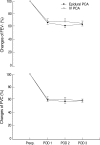Is intravenous patient controlled analgesia enough for pain control in patients who underwent thoracoscopy?
- PMID: 19794994
- PMCID: PMC2752779
- DOI: 10.3346/jkms.2009.24.5.930
Is intravenous patient controlled analgesia enough for pain control in patients who underwent thoracoscopy?
Abstract
This prospective randomized study was conducted to evaluate the efficacy of two common analgesic techniques, thoracic epidural patient-controlled analgesia (Epidural PCA), and intravenous patient-controlled analgesia (IV PCA), in patients undergoing lobectomy by the video-assisted thoracic surgical (VATS) approach. Fifty-two patients scheduled for VATS lobectomy were randomly allocated into two groups: an Epidural PCA group receiving an epidural infusion of ropivacaine 0.2%+fentanyl 5 microg/mL combination at a rate of 4 mL/hr, and an IV PCA group receiving an intravenous infusion of ketorolac 0.2 mg/kg+fentanyl 15 microg/mL combination at a rate of 1 mL/hr. Pain scores were then recorded using the visual analogue scale at rest and during motion (VAS-R and VAS-M, 0-10) for five days following surgery. In addition, we measured the daily morphine consumption, forced vital capacity (FVC), forced expiratory volume in 1 second (FEV(1)), satisfaction score, and the incidence of side effects. Thirty-seven patients out of 52 completed the study (18 in the Epidural PCA group, 19 in the IV PCA group). There were no differences in the pain scores, analgesic requirements, pulmonary function, satisfaction score, and the incidence of side effects between groups. This indicates that IV PCA and Epidural PCA are equally effective to control the postoperative pain after VATS lobectomy, which suggests that IV PCA may be used instead of Epidural PCA.
Keywords: Analgesia, Patient-Controlled; Pain Measurement; Thoracic Surgery, Video-Assisted.
Figures



References
-
- Nagahiro I, Andou A, Aoe M, Sano Y, Date H, Shimizu N. Pulmonary function, postoperative pain, and serum cytokine level after lobectomy: a comparison of VATS and conventional procedure. Ann Thorac Surg. 2001;72:362–365. - PubMed
-
- Landreneau RJ, Hazelrigg SR, Mack MJ, Dowling RD, Burke D, Gavlick J, Perrino MK, Ritter PS, Bowers CM, DeFino J, Nunchuck SK, Freeman J, Keenan RJ, Ferson PF. Postoperative pain-related morbidity; video-assisted thoracic surgery versus thoracotomy. Ann Thorac Surg. 1993;56:1285–1289. - PubMed
-
- Li WW, Lee RL, Lee TW, Ng CS, Sihoe AD, Wan IY, Arifi AA, Yim AP. The impact of thoracic surgical access on early shoulder function: video-assisted thoracic surgery versus posterolateral thoracotomy. Eur J Cardiothorac Surg. 2003;23:390–396. - PubMed
-
- Nakata M, Saeki H, Yokoyama N, Kurita A, Takiyama W, Takashima S. Pulmonary function after lobectomy: video-assisted thoracic surgery versus thoracotomy. Ann Thorac Surg. 2000;70:938–941. - PubMed
-
- Perttunen K, Nilsson E, Kalso E. I.v. diclofenac and ketorolac for pain after thoracoscopic surgery. Br J Anaesth. 1999;82:221–227. - PubMed
Publication types
MeSH terms
Substances
LinkOut - more resources
Full Text Sources
Other Literature Sources
Medical

